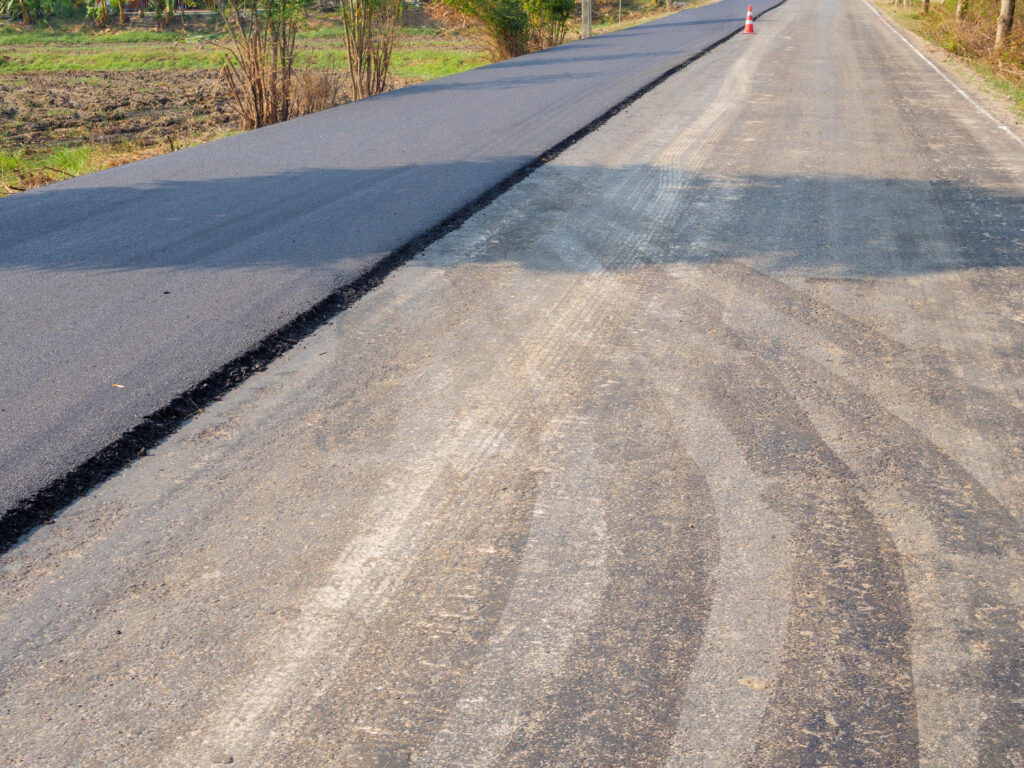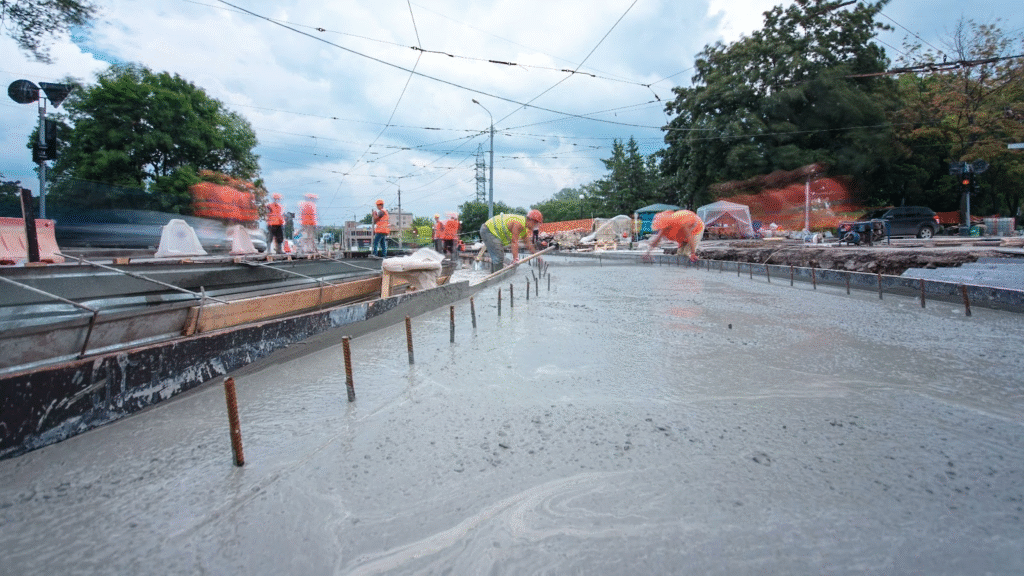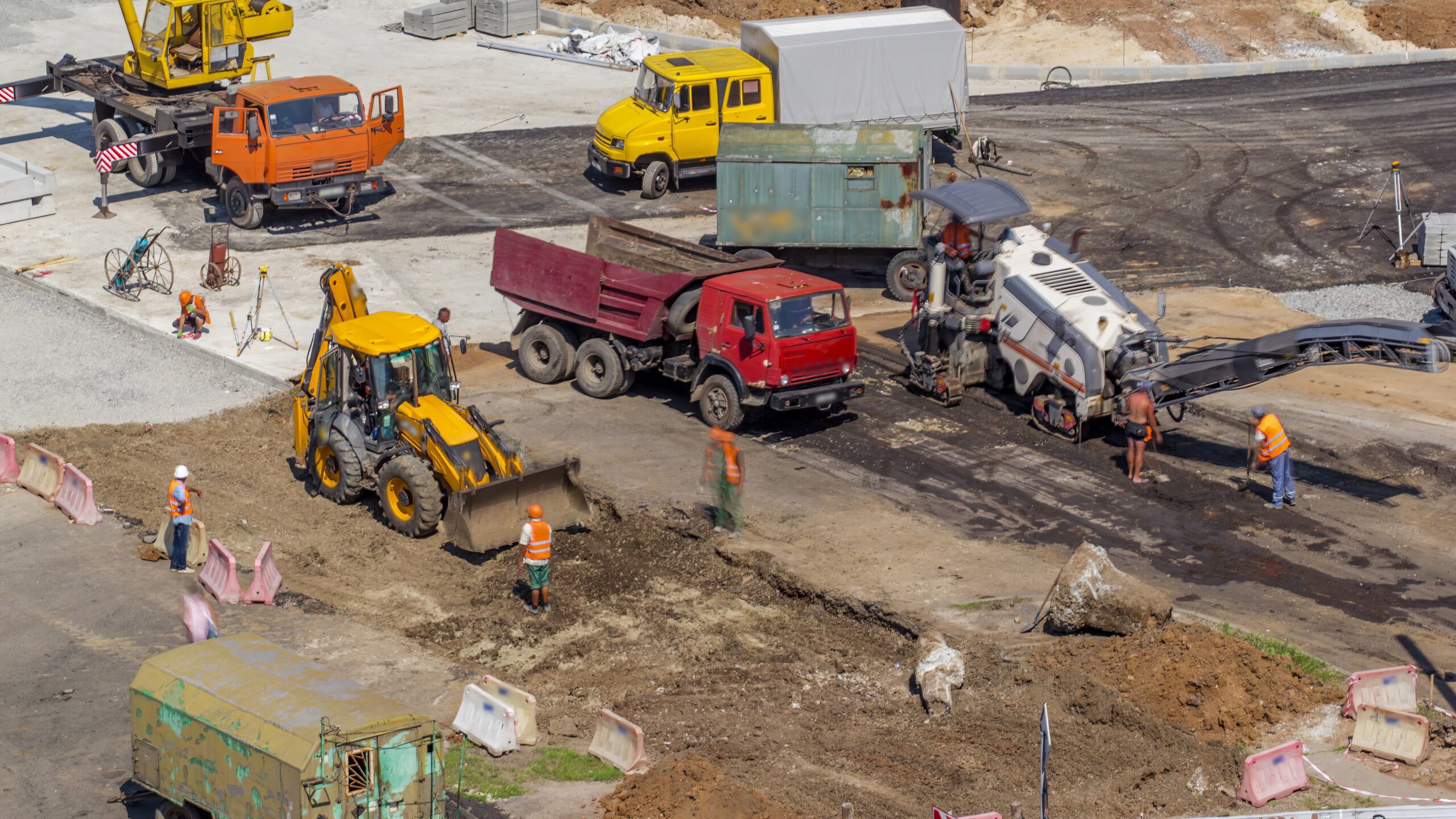
Colorado Springs winters bring heavy snow, quick temperature changes, and frequent freeze-thaw cycles that challenge even the strongest paved surfaces. Snow removal keeps roads, parking lots, and sidewalks safe, but how it’s done plays a big role in how long asphalt and concrete last.
According to research from the Federal Highway Administration (FHWA), environmental factors such as cold weather, moisture, and freeze-thaw cycles account for about 36% of damage to asphalt pavements and 24% of damage to concrete pavements over 15 years. When snow removal practices increase scraping, chemical exposure, and water penetration, they accelerate this deterioration, leading to cracks, potholes, and surface wear.
By learning how snow removal affects different surfaces, Colorado Springs property owners can take steps to protect their pavements and avoid expensive repairs. This blog explores how various snow removal methods affect asphalt and concrete, and which winter parking lot maintenance tips help keep surfaces strong throughout the winter.
The Hidden Effects of Snow and Ice on Pavement Surfaces
When snow sits on a surface, melts during the day, and refreezes overnight, it creates stress that most pavements were never designed to handle continuously.
1. Freeze-Thaw Pressure and Subsurface Damage
Each time water freezes, it expands about nine percent. In pavement layers, that expansion pushes material apart, forming microcracks. As those cracks fill with water and refreeze, they widen and deepen, reaching the base layer. Over an entire Colorado winter, this cycle can occur dozens of times.
2. Water Infiltration Weakening the Base Layer
Once the snow melts, the water seeps into the cracks and joints in the pavement, reaching the base and subgrade beneath. This trapped moisture can weaken the soil, causing soft spots, depressions, and uneven settlement. Over time, the subbase loses its stability, which can lead to further damage to the pavement surface. The moisture trapped in these cracks can also cause the asphalt binder to weaken, increasing the rate of deterioration.
3. Visible Warning Signs of Damage
As winter progresses and the freeze-thaw cycles continue, there are several telltale signs that your pavement may already be experiencing the damaging effects of snow and ice. These early warning signs are crucial for property owners to catch before the damage escalates into costly repairs.
- Fine cracks that grow larger after temperature swings
- Potholes appearing after heavy snowmelt
- Heaving and unevenness in concrete slabs
These signs often indicate that the freeze-thaw cycle has already begun its damaging effects. The key to preventing further damage is early detection and maintenance before the cracks and potholes become larger and more costly to repair.
What’s the first sign of snow-related pavement damage?
The first sign of damage is usually small surface cracks or areas where water pools after melting. These cracks act as pathways for moisture to seep deeper into the pavement, starting the freeze-thaw cycle that worsens over time.
How Snow Removal Equipment Affects Asphalt and Concrete
Snowplows, loaders, and other snow removal equipment can either help or harm paved surfaces, depending on how they’re used. While snow and ice removal is essential for safety during Colorado Springs’ harsh winters, improper snowplow techniques can accelerate pavement deterioration.
Metal Plows and Surface Scraping
Steel blades that are not properly adjusted to the surface can scrape away protective coatings, chip concrete edges, and peel off the top layers of asphalt. Once the surface is compromised, water and deicing chemicals can penetrate the pavement more easily, leading to cracks, potholes, and further degradation.
Curb and Ramp Damage from Heavy Machinery
Concrete curbs, ramps, and ADA-compliant sections often take the brunt of snow removal operations. High plow angles or overextended skid-steer buckets can cause cracks or corner spalling, which can lead to unsafe edges or drainage problems. These areas are particularly vulnerable due to the concentrated pressure exerted by the machinery.
Safer Tools for Pavement Protection
To reduce wear and extend the life of your pavement, consider using the following snow removal tools and techniques:
- Rubber-tipped plows instead of exposed steel blades to prevent surface gouging
- Maintain proper blade height (¼ to ½ inch above the surface) to avoid unnecessary scraping.
- Use polyurethane edges on commercial lots for more flexible contact with the surface.
The optimal attack angle for plowing paved surfaces is about 75°, as determined by the University of Iowa’s 1996 study on snowplow effectiveness. Using the correct angle ensures better snow removal without gouging the surface.
How can property owners reduce plow-related damage?
Work with contractors who use rubber-edged blades and adjustable blade angles for safer snow removal. This simple adjustment can drastically extend the lifespan of your pavement by preventing unnecessary surface damage.
The Chemical Side of Snow Removal
Deicers play a crucial role in keeping roads and parking lots safe during winter by quickly melting ice and snow. However, the wrong deicer can cause long-term damage to both asphalt and concrete surfaces.
Common Deicing Agents in Colorado Springs
Deicing chemicals are essential for winter safety, but can affect the longevity of pavements.
Here’s a look at the most commonly used agents:
- Sodium chloride (rock salt): Affordable but harsh on asphalt, as it strips away the asphalt binder and causes surface damage over time.
- Magnesium chloride: Effective for clearing ice on roads, but can corrode the rebar inside concrete structures.
- Calcium chloride: Fast-acting but highly corrosive, and can cause cracking or surface damage when applied regularly.
- Calcium magnesium acetate (CMA): It is a gentler and environmentally safer alternative that is less harmful to asphalt and concrete surfaces.
Effects on Asphalt
Salts, especially sodium chloride, draw moisture into the asphalt, stripping oils from the binder and drying out the surface. This leads to increased brittleness, causing asphalt cracks and traveling over time. As the asphalt becomes more porous, it becomes more susceptible to water infiltration, exacerbating freeze-thaw damage. Learn how weather causes asphalt to break down.
Effects on Concrete
Concrete is porous, meaning chlorides from deicers can seep into its structure and reach the reinforcement bars (rebar). Once the rebar corrodes, it causes scaling and surface flaking, compromising the structural integrity of the concrete. This damage is especially problematic in areas with heavy freeze-thaw cycles.
What’s the safest deicer for both asphalt and concrete?
Calcium magnesium acetate (CMA) or sand-based traction materials are the safest deicers for mixed surfaces like asphalt and concrete. These alternatives melt ice without damaging the surface material or the reinforcement in concrete, making them the best choice for long-term pavement care.
Why Asphalt and Concrete Respond Differently to Winter Stress
Understanding how asphalt and concrete react to winter conditions is essential for selecting Colorado Springs’s materials and maintenance strategies.
1. Asphalt’s Flexibility
Asphalt’s ability to flex and bend during temperature changes helps it handle Colorado’s extreme temperature fluctuations. However, this flexibility decreases as asphalt ages or when damaged by salt, making it more prone to cracks.
2. Concrete’s Rigidity
Concrete is strong under heavy loads but is less flexible than asphalt. This makes it more vulnerable to freeze-thaw damage, as moisture trapped within concrete pores can freeze, expand, and cause spalling and cracking.
3. Choosing the Right Maintenance Strategy
Different strategies must be applied to asphalt and concrete surfaces based on their unique properties to prevent winter damage.
- For asphalt: Sealcoating every 2-3 years and filling cracks before winter helps protect against moisture penetration and freeze-thaw damage.
- For concrete: Using air-entrained mixes and applying penetrating sealers helps protect concrete from moisture infiltration and freeze-thaw cycles.
The American Concrete Institute (ACI) confirms that air-entrained concrete can survive up to 300 freeze-thaw cycles without significant structural loss. It is a durable choice for freeze-thaw areas like Colorado Springs.
Can asphalt and concrete be protected the same way?
No, each material requires a unique maintenance approach. Asphalt is protected with surface sealants, while concrete needs deep-penetrating sealers to prevent freeze-thaw damage. Both require tailored winter care plans for optimal durability.
Common Damage Seen After Colorado Springs Winters
Winter in Colorado Springs can be tough on pavements, even with careful snow removal. Here’s a look at the typical damage caused by the harsh winter conditions.
1. Asphalt Damage
Asphalt surfaces often show the following types of damage after a Colorado winter:
- Potholes and cracking: Caused by freeze-thaw cycles and moisture infiltration.
- Faded striping and oxidized surfaces: Weather and UV rays wear down surface coatings.
- Raveling: The loss of fine aggregate texture, weakening the asphalt’s surface.
2. Concrete Damage
Concrete surfaces are also vulnerable to winter stress. Common damage includes:
- Scaling, flaking, and spalling: Freeze-thaw cycles cause the concrete’s surface to break down.
- Edge chipping at joints and curbs: Snow removal equipment can chip the edges of concrete.
- Trip hazards: Uneven slabs due to heaving from moisture freezing inside the concrete.
How soon after winter should pavement repairs start?
Pavement repairs should begin as soon as temperatures consistently stay above 45°F. Early repairs prevent small cracks from turning into larger structural issues.
Smart Maintenance Steps Before and After Snow Season
To avoid costly winter damage, follow these key maintenance steps before, during, and after the snow season.
1. Pre-Winter Preparation
Before the first snowflake falls, get your pavement ready:
- Seal visible cracks and apply a protective sealant.
- Verify drainage and grading to ensure meltwater flows freely.
- Mark curbs and islands with snow stakes to guide plows.
2. Post-Winter Recovery
Once winter is over, inspect your pavement for new damage:
- Inspect for cracks, potholes, and low spots caused by the winter weather.
- Schedule patching and re-striping before traffic picks up in the spring.
3. Ongoing Preventive Maintenance
Stay ahead of future damage with regular maintenance:
- Annual crack sealing and drainage cleaning.
- Reapply protective coatings every few years to maintain the surface.
Can I delay sealcoating if my asphalt looks fine?
No. Sealcoating is preventive, not reactive; it protects the surface from oxidation and salt damage before cracks form.
Best Snow Removal Practices for Colorado Springs Businesses

Snow removal doesn’t just improve safety; it can also save your business money by extending the life of your pavement.
- Choose Trained Crews: It’s crucial to select contractors who specialize in commercial snow removal and understand how to protect your pavement during the winter. Trained professionals will be familiar with proper techniques that prevent long-term damage.
- Plan for Schedules and Access: Proper planning ensures minimal disruption to your business while maintaining compliance with accessibility regulations. Coordinating snow removal times will allow you to keep business operations running smoothly during and after snow events while ensuring that your property remains accessible to everyone.
- Set Up Maintenance Contracts: Multi-year maintenance contracts can bundle snow removal and pavement upkeep, saving time and reducing overall repair costs.
Long-Term Benefits of Proper Winter Care
Proper winter care offers more than just protection against the harsh winter conditions—it brings significant long-term advantages that improve the overall performance and value of your pavement.
- Longer-lasting pavement: Consistent maintenance helps reduce wear and tear, leading to fewer repairs and an extended lifespan for both asphalt and concrete surfaces.
- Reduced liability: Proactive care minimizes safety hazards like slip and trip risks, ensuring your property remains safe for tenants, customers, and employees.
- Improved curb appeal: Well-maintained surfaces not only look better but can also increase the property’s overall value, making it more attractive to potential tenants or buyers.
- Lower lifecycle costs: Routine care, such as crack sealing and sealcoating, reduces the need for expensive repairs and replacements, resulting in lower long-term maintenance expenses.
- Enhanced safety and accessibility: Proper snow removal and maintenance ensure clear, accessible pathways, reducing the risk of accidents and improving the property’s functionality during winter.
- Environmental protection: Regular sealing and snow removal practices can help protect the surrounding environment by reducing the harmful impact of chemicals like deicers on nearby vegetation and waterways.
- Higher tenant satisfaction: Well-maintained parking lots and walkways create a safer, more pleasant environment, leading to greater tenant satisfaction and retention.
How Asphalt Coatings Company Protects Colorado Pavements
For over 40 years, Asphalt Coatings Company has protected Colorado Springs properties from harsh winters with expert paving and maintenance services.
- Local expertise: We understand the unique freeze-thaw challenges in Colorado Springs.
- In-house crews: Our skilled team handles every phase of the job.
- Advanced equipment: We use state-of-the-art tools for precision and durability.
- Maintenance programs: Our contracts cover crack sealing, sealcoating, and concrete repair.
Protect Your Pavement Before the Next Storm
Snow removal in Colorado Springs isn’t just about keeping surfaces clear, it’s about protecting your investment. The proper techniques, materials, and maintenance plan can distinguish between pavement that lasts decades and one that fails within years.
If your parking lot, driveway, or concrete surface needs pre-winter care or post-winter repair, trust the experts who know Colorado weather best.
Contact us today for a Request Free Quote from Asphalt Coatings Company and get a customized plan to keep your pavement strong, safe, and snow-ready all year.
Frequently Asked Questions
Can heated pavement systems prevent snow damage?
Yes, but they are expensive to install. Radiant systems keep surfaces above freezing, eliminating most freeze–thaw stress in high-priority zones like ramps or hospital entrances.
What’s the ideal snowplow blade height for asphalt lots?
Maintain a clearance of ¼ to ½ inch. It prevents scraping sealcoat while still removing compacted snow effectively.
How often should commercial lots be inspected in winter?
After every major snow event or once weekly during heavy snow months to catch plow or chemical damage early.
Are sand or grit better than salt for traction?
Sand adds traction without chemical corrosion. Use it in shaded or low-traffic areas to minimize dust.
Does sealing concrete before winter actually help?
Yes. Penetrating sealers block water absorption, reducing freeze-induced scaling and extending service life by several years.



